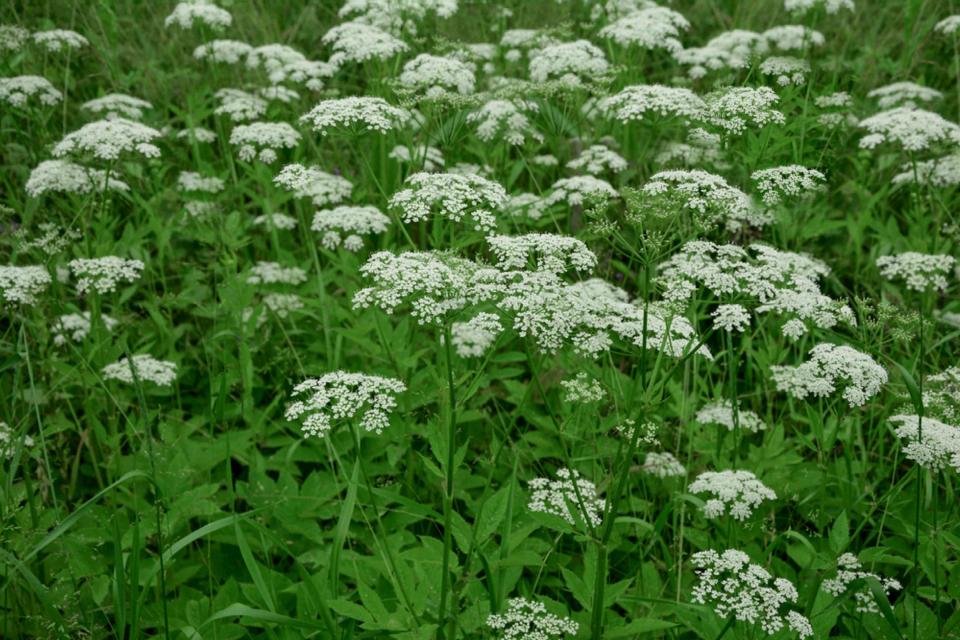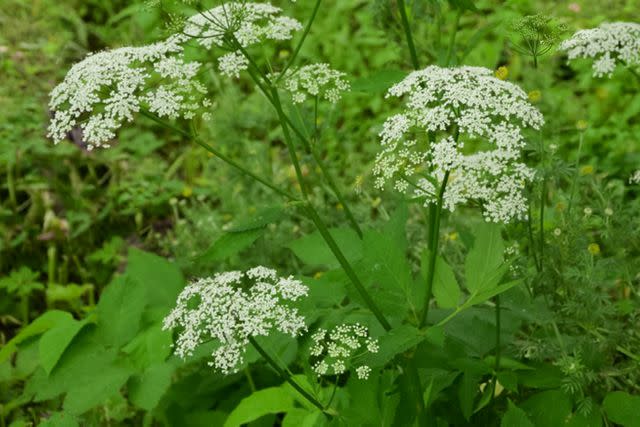How to Grow and Care for Goutweed (Bishop's Weed)
A fast-growing ground cover that can easily get out of control

The Spruce / K. Dave
Several plant species are referred to as goutweed, also known as bishop's weed. The most popular is Aegopodium podagraria. This is a herbaceous perennial that works well as a shrubby, semi-wild ground cover option. It's fast-growing, hardy, and low-maintenance when restrained. The leafy, spreading foliage normally doesn't grow much taller than 10 inches, but the flowering stalks that appear in late spring or early summer can shoot up much taller. The plant's ability to grow in shady locations and a wide variety of soil types make it a good option for cover under a group of trees. The spreading roots system can be helpful if you're looking for plants to help tackle steep-sided soil erosion.
It readily self seeds and its rhizomatous roots mean that it can be an aggressive spreader and difficult to eradicate once established. If you're not careful, the leafy mounds could quickly take over your entire garden. It is classified as an invasive species across most of the United States.
Common Name | Goutweed, bishop's weed, cow parsley, ground elder |
Botanical Name | Aegopodium podagraria |
Family | Apiaceae |
Plant Type | Herbaceous, perennial |
Mature Size | 6-36 in. tall, 12-18 in. wide |
Sun Exposure | Full, partial, shade |
Soil Type | Well-drained |
Soil pH | Acid, neutral, alkaline |
Bloom Time | Summer |
Flower Color | White |
Hardiness Zones | 4-9 (USDA) |
Native Area | Europe, Asia |
Goutweed Care
Goutweed, or bishop's weed, is an effective ground cover that requires diligence to keep in check. Here are the main care requirements for growing goutweed:
Place in partial shade for best results.
Plant in well-drained soil of any pH level.
Opt for a moist, canopied area to mimic its native, forested environment.
Goutweed is classified as an invasive species across most of the United States. If you do plan to plant it, you might want to limit it to spots where other plants struggle to survive or between physical barriers. There's a variegated variety of the plant that is known for being less invasive, and this tends to be the most popular choice in gardens.

The Spruce / K. Dave

The Spruce / K. Dave

The Spruce / K. Dave
Light
Goutweed has a preference for partial shade conditions, but it can still do well in full shade and also full sun, providing it receives sufficient moisture. It will not flower as well under dense shade. Intense, direct sun can result in leaf scorch.
Soil
This plant isn't fussy when it comes to soil types, providing it's well-drained. It can also grow well in a wide range of pH levels, but it does seem to enjoy slightly acidic soils most.
Water
In its native environments, goutweed is often found in damp forested areas, and it has a preference for moist conditions. It can even survive in saturated ground, and some gardeners will use it around pond areas. Water weekly if there is no rainfall. To avoid root rot, allow the top part of the soil to dry out before watering.
Temperature and Humidity
Goutweed can withstand very hot and very cold temperatures—its tolerance of extremes is one of the reasons it's so hard to keep the plant in check. The seeds of goutweed do need cold winters in damp soil to germinate. The plant is not affected by high humidity.
Fertilizer
Given how hardy this plant is, it doesn't need regular fertilization to thrive. In poor soils, however, some gardeners will add additional organic matter.
Pruning
Deadheading the flowers before they go to seed can help with spreading. However, it's primarily the rhizomatous roots that make this plant so aggressive.
Many gardeners cut the flowering stalks back completely as they can look rather untidy if you're using goutweed as a ground cover option.
Propagating Goutweed
Dividing this plant or nurturing new growth from cuttings of the rhizomes is easy. It's best to plant the divisions directly into the garden in the spring. Goutweed can be propagated through cutting rhizomes. Here’s how:
Locate a rhizome, ideally in the spring, and dig underneath to lift it out of the ground.
Using a clean, sharp knife, cut the rhizome into pieces with roots and shoots attached.
Plant pieces directly in the ground or a planter bed at the same depth as the original plant.
Water well until established.
How to Grow Goutweed From Seed
Goutweed is easy to grow from seed. Again, it's best to do this in the spring. Seeds need cold stratification and moist soil to germinate. The seeds will benefit from being sown in a cold frame before the germinated seedlings are planted out in the summer.
Overwintering
No specific care is needed. Goutweed is hardy enough to survive cold winters without additional protection.
Common Pests & Plant Diseases
Known for being a hardy plant, goutweed is not badly impacted by either pests or diseases. If grown in a hot and humid region, however, the plant can suffer from leaf blight. Mowing the foliage back can be enough to rejuvenate it.
How to Get Goutweed to Bloom
Bloom Months
Goutweed blooms in late spring to midsummer, usually May and June, with small, white flowers.
What Do Goutweed Flowers Look and Smell Like?
Flower umbels are 2-4 inches across, flat or dome-shaped, and white. They rise on hollow stems up to 2 feet above the foliage. Goutweed flowers are attractive to bees, butterflies and birds.
Deadheading Goutweed Flowers
The flower umbels aren't particularly ornamental, and some people simply cut the flowering stalks back to prevent the ground cover from looking untidy. Deadhead when the blooming season is over.
Common Problems With Goutweed
Goutweed doesn't struggle with many pests or diseases, but it can be difficult to eradicate.
Invasive Growing
Mow or use a weed-whacker to get your goutweed as short as you can to help control it. To try to eradicate completely, dig deep, around 2 feet, and remove all roots and rhizomes. Avoid composting.
Frequently Asked Questions
How tall does goutweed grow?
Goutweed usually grows about 8" tall but the flowering stems can rise to 36 inches.
How can I get rid of goutweed?
While goutweed is notoriously difficult to eradicate, moving short or digging deep to remove all roots can be effective. You can also cover the growing area with black plastic sheeting just as leaves begin to emerge in spring. Leave the plastic in place throughout the summer.
Where should I place goutweed?
Goutweed can grow in any light condition (shade, partial shade, full sun), although it flowers best in dappled shade. It also tolerates most soil types.

